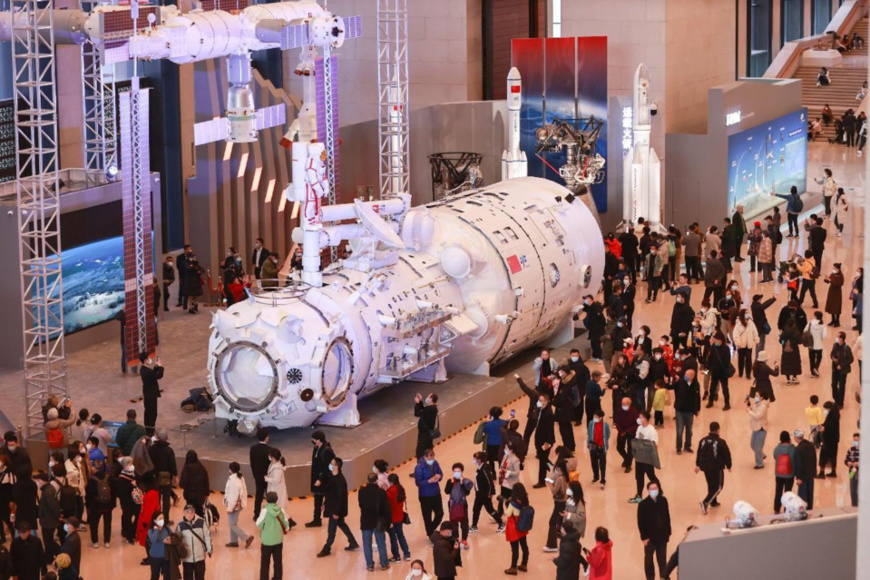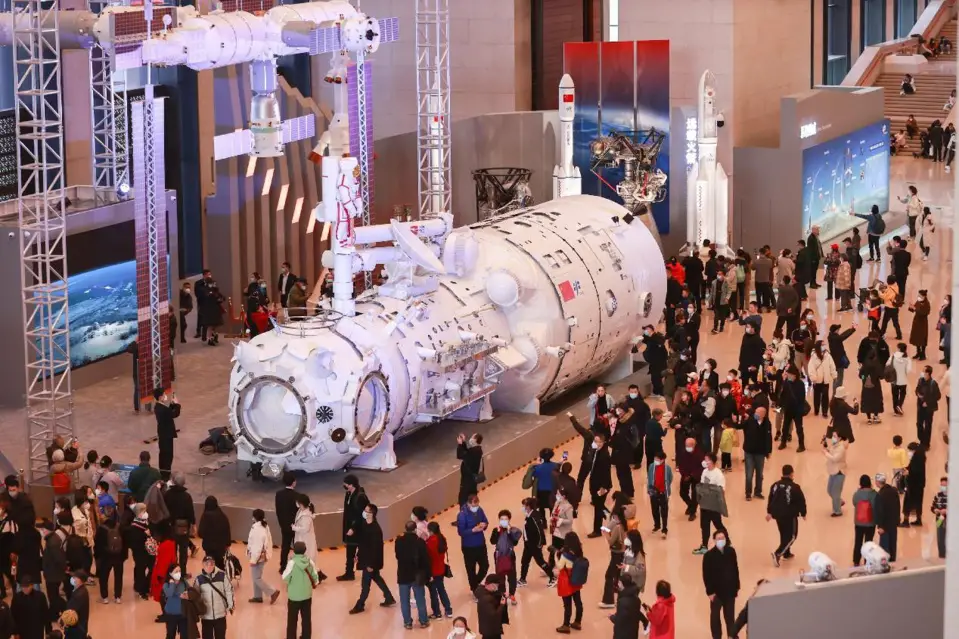By He Yin, People's Daily

A model combination of the Tianhe core module and China's space station is exhibited at the National Museum of China, Feb. 28, 2023. (Photo by Chen Xiaogen/People's Daily Online)
Sci-tech innovation remained one of the important topics that received wide attention from the international society during this year's "two sessions," the annual gatherings of the National People's Congress and the National Committee of the Chinese People's Political Consultative Conference.
As international sci-tech cooperation faces impacts and challenges from unilateralism and protectionism pursued by a few countries, China, while working to improve its capability in sci-tech innovation, is committed to launching sci-tech cooperation with other countries, for which it has won wide applause.
China is constantly making important original sci-tech achievements today.
China's space station, Tiangong, features a basic three-module configuration consisting of the core module, Tianhe, and two lab modules, Wentian and Mengtian. It is designed to be a versatile space lab, capable of accommodating 25 experiment cabinets for scientific exploration.
China has achieved rapid quantum computer development, with the launches of "Jiuzhang," "Zuchongzhi," and "Zuchongzhi 2" in recent years. Similar to conventional computers, quantum computers also need software to manage hardware devices, run applications, and provide a user interface.
Claudia Vernotti, co-founder and director of of Belgian non-profit organization ChinaEU, said that China's progress in sci-tech innovation is very impressive, from the top-level design to the translation of achievements and to the innovation in commercial models.
If there is a lush forest, giant trees naturally grow there, and China has long been nurturing forests, said a recent report by Russian media outlet RIA Novosti.
China has always placed sci-tech innovation in a central place in its development strategy. It follows a path of independent innovation with Chinese characteristics. The importance attached by the country on sci-tech innovation, the frequency of policies it has issued to promote sci-tech innovation and the efforts it has made to advance sci-tech innovation are unprecedented.
China's gross domestic expenditure on R&D increased to 3.09 trillion yuan ($449 billion) last year, from 1 trillion yuan in 2012. It accounted for 2.55 percent of the country's GDP, up from 1.91 percent during the same period. The number of R&D personnel rose from 3.25 million in 2012 to over 6 million in 2022. The Chinese mainland has climbed to 11th place on the Global Innovation Index 2022 released by the World Intellectual Property Organization (WIPO), from 34th in 2012. The steady progress in the 10-year period is incomparable among all upper middle-income economies.
"China's growth (in GII ranking) from 34th ten years ago to 11th (in 2022) ... is really spectacular. The close attention paid by the government and the country to innovation as an engine of growth is paying off," WIPO Director General Daren Tang said at the press launch of GII 2022.
"The Chinese government takes IP (intellectual property) very seriously. They have five-year strategic plans in which they are able to harmonize IP policy making with all the related elements. China nurtures its innovation ecosystem in a holistic, comprehensive manner," he said.
To achieve greater self-reliance and strength in science and technology is a path that China must take to promote high-quality development.
Education, science and technology, and human resources are the foundational and strategic pillars for building a modern socialist country in all respects. China regards science and technology as its primary productive force, talent as its primary resource, and innovation as its primary driver of growth. It has fully implemented the strategy for invigorating China through science and education, the workforce development strategy, and the innovation-driven development strategy.
With dynamic entities of innovation, policies to boost innovation and an increasingly better environment for innovation, the country will constantly enhance its capability in driving development with innovation and enjoy stronger power for high-quality development.
Openness and cooperation are the sure way to achieve progress in science and technology and growth of productivity.
To achieve common development, international cooperation as well as openness and sharing are needed more than ever. No country can become an innovation hub all by itself or keep all the outcomes of innovation to itself.
China actively shares sci-tech development outcomes with relevant parties, and attaches high importance to applying innovation outcomes in climate change response, energy, environment, agriculture, health and other sectors concerning human's wellbeing. It makes China a better innovator and benefits the world with more of Chinese innovation achievements.
Bambang Suryono, chairman of Indonesian think tank Asia Innovation Study Center, noted deepening technological exchanges with China and introducing more Chinese innovative technologies will significantly improve the sci-tech level of developing countries and is conducive to narrowing the technological gap between themselves and developed nations.
Sci-tech innovation is a strong force driving human progress. China will stay committed to the innovation-driven development strategy, promote high-quality economic development with greater self-reliance and strength in science and technology, promote the openness, trust and cooperation of the international sci-tech community, and make greater contributions to human progress with more major innovative innovations and breakthroughs in key technologies.
As international sci-tech cooperation faces impacts and challenges from unilateralism and protectionism pursued by a few countries, China, while working to improve its capability in sci-tech innovation, is committed to launching sci-tech cooperation with other countries, for which it has won wide applause.
China is constantly making important original sci-tech achievements today.
China's space station, Tiangong, features a basic three-module configuration consisting of the core module, Tianhe, and two lab modules, Wentian and Mengtian. It is designed to be a versatile space lab, capable of accommodating 25 experiment cabinets for scientific exploration.
China has achieved rapid quantum computer development, with the launches of "Jiuzhang," "Zuchongzhi," and "Zuchongzhi 2" in recent years. Similar to conventional computers, quantum computers also need software to manage hardware devices, run applications, and provide a user interface.
Claudia Vernotti, co-founder and director of of Belgian non-profit organization ChinaEU, said that China's progress in sci-tech innovation is very impressive, from the top-level design to the translation of achievements and to the innovation in commercial models.
If there is a lush forest, giant trees naturally grow there, and China has long been nurturing forests, said a recent report by Russian media outlet RIA Novosti.
China has always placed sci-tech innovation in a central place in its development strategy. It follows a path of independent innovation with Chinese characteristics. The importance attached by the country on sci-tech innovation, the frequency of policies it has issued to promote sci-tech innovation and the efforts it has made to advance sci-tech innovation are unprecedented.
China's gross domestic expenditure on R&D increased to 3.09 trillion yuan ($449 billion) last year, from 1 trillion yuan in 2012. It accounted for 2.55 percent of the country's GDP, up from 1.91 percent during the same period. The number of R&D personnel rose from 3.25 million in 2012 to over 6 million in 2022. The Chinese mainland has climbed to 11th place on the Global Innovation Index 2022 released by the World Intellectual Property Organization (WIPO), from 34th in 2012. The steady progress in the 10-year period is incomparable among all upper middle-income economies.
"China's growth (in GII ranking) from 34th ten years ago to 11th (in 2022) ... is really spectacular. The close attention paid by the government and the country to innovation as an engine of growth is paying off," WIPO Director General Daren Tang said at the press launch of GII 2022.
"The Chinese government takes IP (intellectual property) very seriously. They have five-year strategic plans in which they are able to harmonize IP policy making with all the related elements. China nurtures its innovation ecosystem in a holistic, comprehensive manner," he said.
To achieve greater self-reliance and strength in science and technology is a path that China must take to promote high-quality development.
Education, science and technology, and human resources are the foundational and strategic pillars for building a modern socialist country in all respects. China regards science and technology as its primary productive force, talent as its primary resource, and innovation as its primary driver of growth. It has fully implemented the strategy for invigorating China through science and education, the workforce development strategy, and the innovation-driven development strategy.
With dynamic entities of innovation, policies to boost innovation and an increasingly better environment for innovation, the country will constantly enhance its capability in driving development with innovation and enjoy stronger power for high-quality development.
Openness and cooperation are the sure way to achieve progress in science and technology and growth of productivity.
To achieve common development, international cooperation as well as openness and sharing are needed more than ever. No country can become an innovation hub all by itself or keep all the outcomes of innovation to itself.
China actively shares sci-tech development outcomes with relevant parties, and attaches high importance to applying innovation outcomes in climate change response, energy, environment, agriculture, health and other sectors concerning human's wellbeing. It makes China a better innovator and benefits the world with more of Chinese innovation achievements.
Bambang Suryono, chairman of Indonesian think tank Asia Innovation Study Center, noted deepening technological exchanges with China and introducing more Chinese innovative technologies will significantly improve the sci-tech level of developing countries and is conducive to narrowing the technological gap between themselves and developed nations.
Sci-tech innovation is a strong force driving human progress. China will stay committed to the innovation-driven development strategy, promote high-quality economic development with greater self-reliance and strength in science and technology, promote the openness, trust and cooperation of the international sci-tech community, and make greater contributions to human progress with more major innovative innovations and breakthroughs in key technologies.
 Menu
Menu
 China to benefit world with more sci-tech innovation achievements
China to benefit world with more sci-tech innovation achievements
















